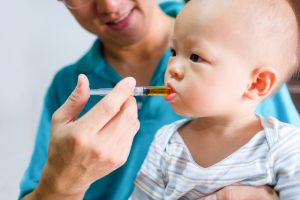 When your child is sick, you probably want to do just about anything to get her to feel better. For many parents, that includes asking their pediatrician to prescribe antibiotics. Despite your desire to heal your little one, it’s important to stop and ask, “Are antibiotics the right choice?” The short answer to that question: It depends. In some cases antibiotics are necessary (more on this below), but we need to be careful about when and how we use them. Antibiotics can heal, but in some cases they can also do harm. In order to better understand the role of antibiotics for children, keep these facts in mind.
When your child is sick, you probably want to do just about anything to get her to feel better. For many parents, that includes asking their pediatrician to prescribe antibiotics. Despite your desire to heal your little one, it’s important to stop and ask, “Are antibiotics the right choice?” The short answer to that question: It depends. In some cases antibiotics are necessary (more on this below), but we need to be careful about when and how we use them. Antibiotics can heal, but in some cases they can also do harm. In order to better understand the role of antibiotics for children, keep these facts in mind.
Highlights:
|
Antibiotic Facts
Antibiotics are used to fight bacterial infections, not viral infections.
When babies or toddlers show signs of a cold or flu, parents and caregivers will often ask if antibiotics are the right choice. However, antibiotics are designed to fight bacteria, not viruses. In most cases, a young child with a mild case of a runny nose, cough, sore throat, or congestion will get better without medication. Remember that babies and toddlers will get between 8-10 colds a year, so it’s a good idea to be mindful when you reach into the medicine cabinet. There are situations when a virus can turn into a bacterial infection, but taking antibiotics before a bacterial infection appears can cause side effects, such as vomiting or diarrhea, or create an infection caused by resistant bacteria.
Antibiotics can cause side effects and other potential problems.
Dr. Iona Munjal, director of the Pediatric Antimicrobial Stewardship Program at The Children’s Hospital at Montefiore Medical Center in New York, states that about 1 in every 10 children will experience side effects from antibiotics. These side effects typically come in the form of an upset tummy (nausea, vomiting, or diarrhea). Antibiotics are designed to kill bad bacteria, but unfortunately, they can also kill good bacteria in the gut, resulting in stomach pain for some little ones. It’s important to also know that only 5 in 100 children are allergic to antibiotics. You should let your doctor know as soon as possible if your baby or toddler has a reaction to antibiotics, such as hives, a rash, welts, or itchy skin.
Lastly, a critical issue of concern is antibiotic resistance. The more antibiotics are used, the less effective they are at killing certain types of bacteria. Out of all the medications prescribed to children, about a quarter of them are antibiotics, and experts say that at least 30% of those prescriptions are unnecessary. Antibiotic resistance is actually quite serious. It means all of us need to be careful about how much we depend on antibiotics, not just babies and toddlers. When we develop a resistance to antibiotics, we also become vulnerable to infectious diseases – a key reason to be cautious about antibiotic use.
There are cases when your baby or toddler will need antibiotics.
Your baby or toddler may face an illness that requires antibiotics, such as:
- Prolonged high fever (a fever of 100.4° in babies younger than 3 months and 102° in babies older than 3 months)
- Bacterial pneumonia
- Whooping cough
- Ear infections
- Urinary tract infections
- Other bacterial infections
When giving your baby or toddler antibiotics, it’s important to continue the treatment for the prescribed length of time
If you give your child antibiotics and start to see improvement as symptoms subside, can you stop using them? The current recommendation is that in order for the antibiotic to do its job, it’s important to continue the treatment for the length of time prescribed by your pediatrician. Cutting off an antibiotic treatment early may cause the infection to return.
Antibiotics are like having superpowers: We have to use them responsibly or else a lot of people can get sick! Remember to keep these antibiotic facts in mind when your child is sick, and always consult your pediatrician before giving your child any medication.








